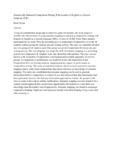Please use this identifier to cite or link to this item:
https://cris.library.msu.ac.zw//handle/11408/3819Full metadata record
| DC Field | Value | Language |
|---|---|---|
| dc.contributor.author | Nyoni, Erick | - |
| dc.date.accessioned | 2020-07-23T09:57:00Z | - |
| dc.date.available | 2020-07-23T09:57:00Z | - |
| dc.date.issued | 2012 | - |
| dc.identifier.uri | http://ijhssnet.com/journals/Vol_2_No_18_October_2012/31.pdf | - |
| dc.identifier.uri | http://hdl.handle.net/11408/3819 | - |
| dc.description.abstract | Using an experimental design and an interview guide for teachers, the study sought to establish the effectiveness of using semantic mapping in enhancing composition writing with learners of English as a Second Language (ESL). A class of 44 ESL Form Three students participated in the study. First the researcher gave a composition (Composition A) to the 44 students without giving the students any pre-writing activity. The class was randomly divided into two groups of 22 students each. One group was given Composition B without any pre-writing activity. The second group was taught the skill of semantic mapping as a prewriting activity for Composition B. Students were only identified with numbers. The class was not known to the researcher. Compositions were marked and recorded separately for the two groups. A comparison of performance was made for results inComposition A and Composition B to see if using semantic mapping had any impact on performance in composition writing. The study revealed that students who have been exposed to semantic mapping tend to write better compositions than those who have no knowledge of semantic mapping. The study also established that semantic mapping can be used to generate information before a composition is written. It was also observed that after information had been generated, students who had any information gaps had the teacher, the groups or the class to come to their aid in making clarifications. Semantic mapping was also found to be a student centred approach that created more opportunities for students to create their own knowledge than the teacher centred approaches. Semantic mapping was found to encourage cooperative learning. Pupils are more placed to benefit from their learning if they assist each other in doing so. | en_US |
| dc.language.iso | en | en_US |
| dc.subject | second language | en_US |
| dc.subject | English as a Second Language | en_US |
| dc.title | Semantically Enhanced Composition Writing With Learners of English as a Second Language (ESL) | en_US |
| dc.type | Article | en_US |
| item.fulltext | With Fulltext | - |
| item.grantfulltext | open | - |
| item.openairetype | Article | - |
| item.cerifentitytype | Publications | - |
| item.languageiso639-1 | en | - |
| item.openairecristype | http://purl.org/coar/resource_type/c_18cf | - |
| Appears in Collections: | Research Papers | |
Files in This Item:
| File | Description | Size | Format | |
|---|---|---|---|---|
| Semantically Enhanced Composition Writing With Learners of English as a Second Language.pdf | Abstract | 5.52 kB | Adobe PDF |  View/Open |
Page view(s)
110
checked on Nov 23, 2025
Download(s)
16
checked on Nov 23, 2025
Google ScholarTM
Check
Items in MSUIR are protected by copyright, with all rights reserved, unless otherwise indicated.



